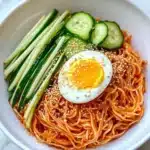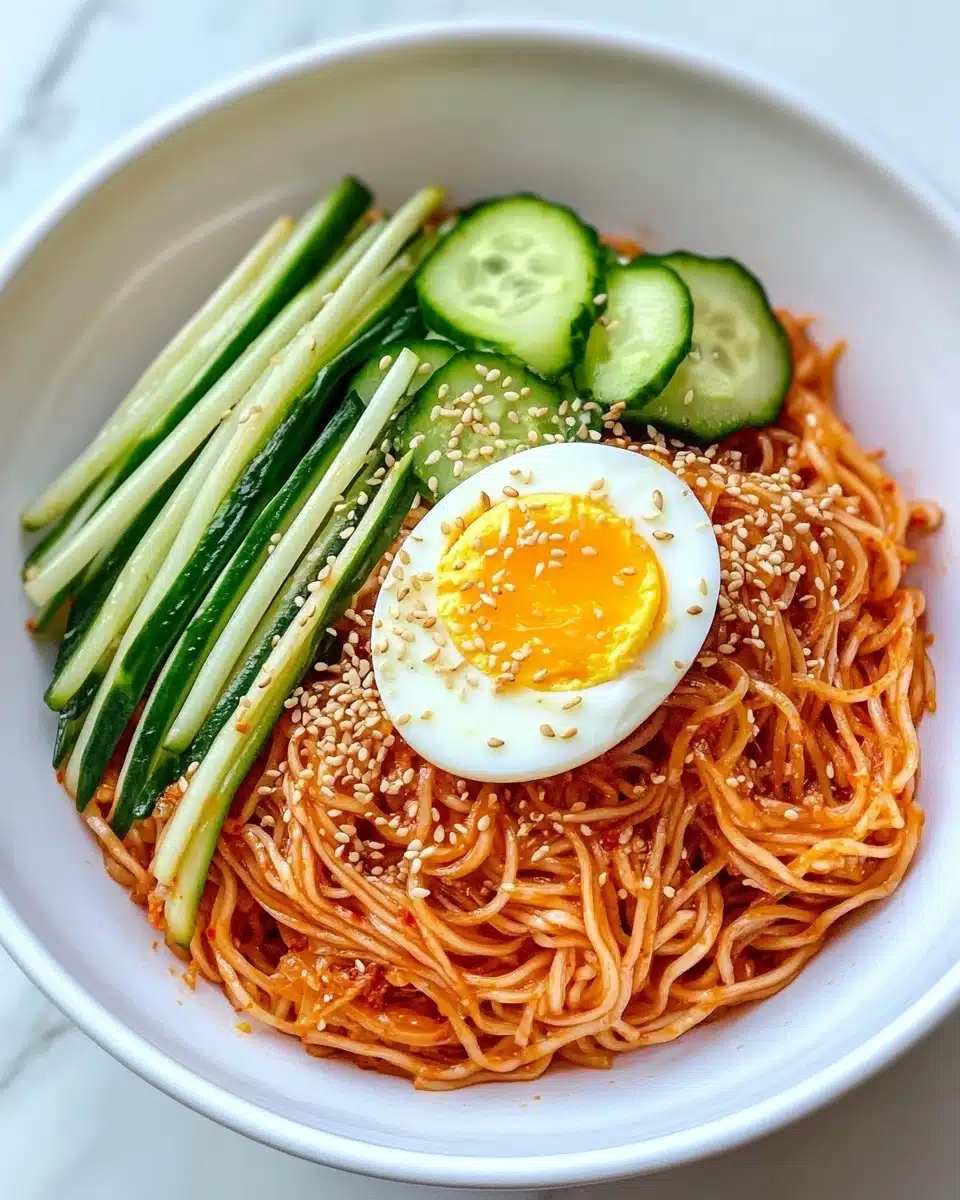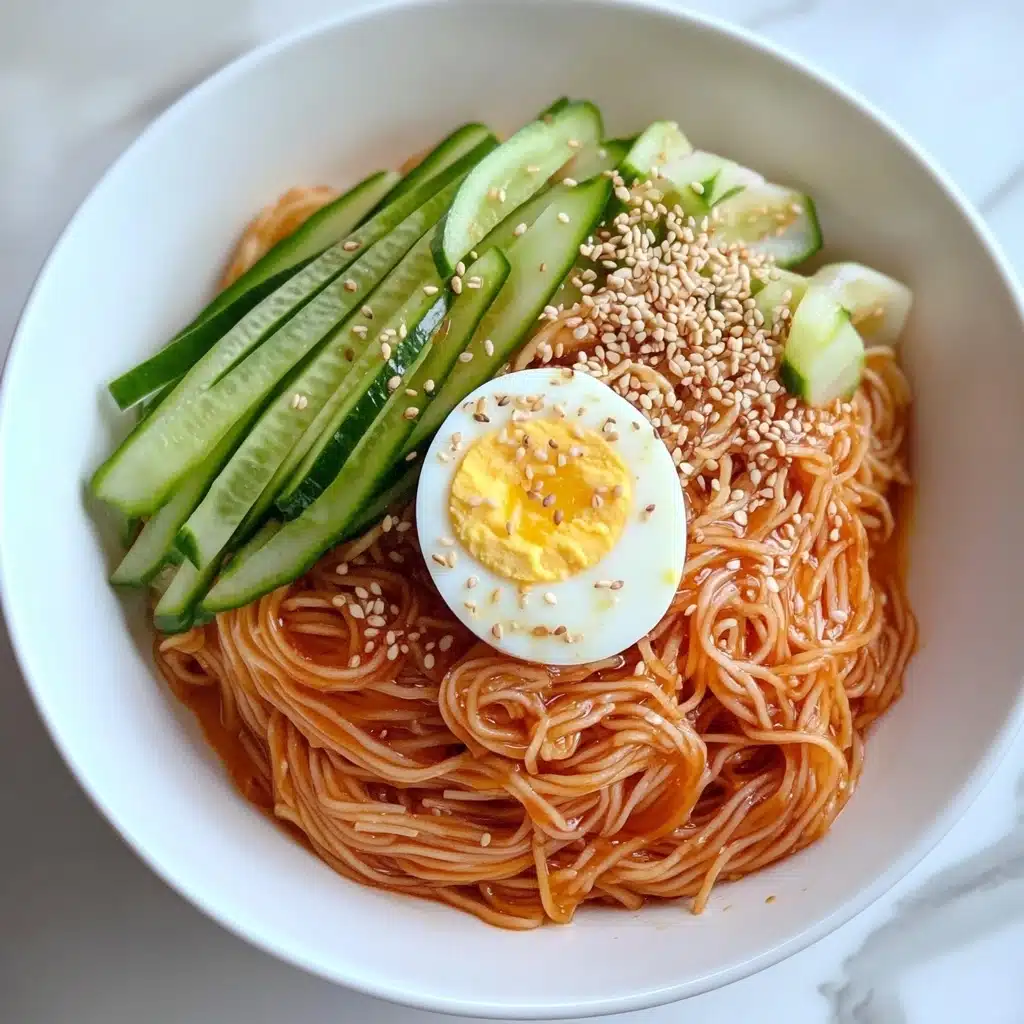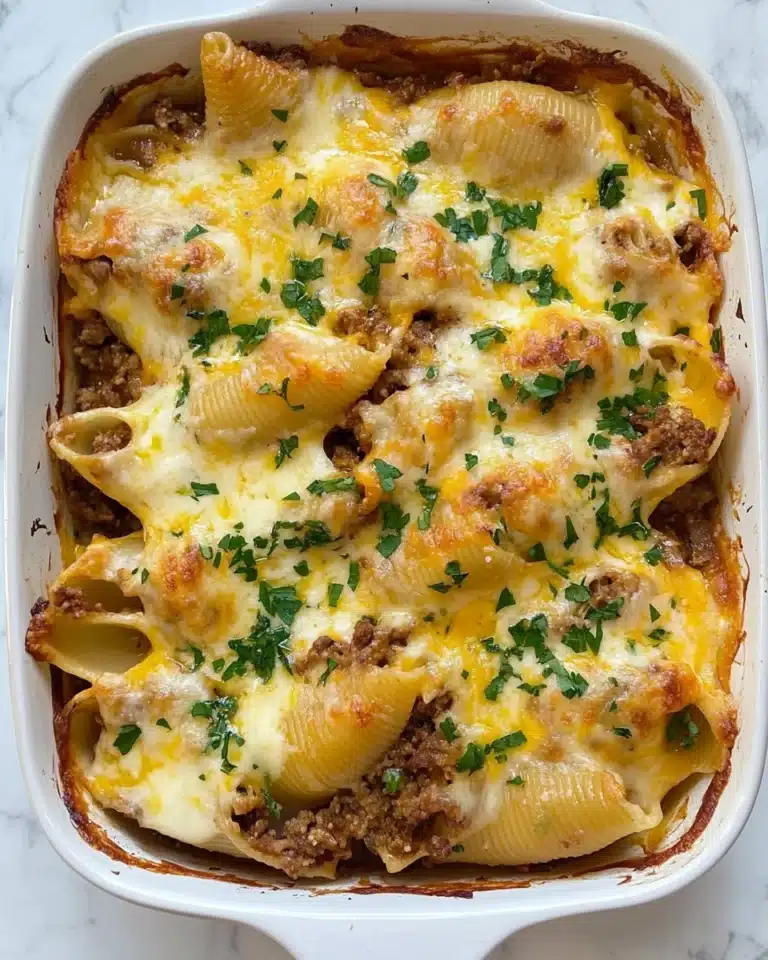Bibim Guksu is the fiery, refreshingly cold Korean noodle dish you didn’t know you were missing—a spicy, tangy, and ever-so-satisfying bowl that bursts with flavor and crunch in every bite. If you love bold tastes and crave something quick, light, yet incredibly memorable, this is the recipe you’ll want on repeat all summer!
Why You’ll Love This Recipe
- Unbeatable Refreshment: Each twirl of cold noodles and crunchy veg is an instant cool-down on a hot day.
- Bold, Layered Flavors: You’ll adore how the spicy, tangy, sweet, and savory notes mingle in every mouthful of Bibim Guksu.
- Lightning-Fast & Minimal Fuss: This dish takes barely more than 10 minutes from cravings to chopsticks—ideal for busy days or spontaneous lunches.
- Totally Customizable: Play with the toppings or heat level to make Bibim Guksu your very own signature bowl.
Ingredients You’ll Need
The real magic of Bibim Guksu lies in its beautiful simplicity—every ingredient is both purposeful and easy to source, yet together they create fireworks of taste and color. Choose quality, and you’ll turn a humble noodle bowl into something utterly addicting.
- Somyeon (8 oz): These thin wheat noodles cook rapidly and have the perfect chewy, springy texture to soak up all that flavorful sauce.
- Fermented kimchi (1/2 cup): Provides crunch and punchy tang; the fresher and funkier the kimchi, the livelier the final bowl.
- Kimchi brine (3 tbsp): Liquid gold! Gives the sauce an irresistible depth of spicy-savory flavor.
- Gochujang (1/4 cup): The iconic Korean chili paste—use extra spicy for a real kick, or mild if you’re easing in.
- Fine gochugaru (1 tsp): Korean red pepper flakes dial up the color and heat—go for fine grind for a silkier sauce.
- Sugar (3 tbsp): Balances the chili’s heat and kimchi’s acidity; any sugar will do, including raw or brown.
- Plum or rice vinegar (3 tbsp): For an extra tangy lift and subtle fruitiness—plum vinegar is classic but rice vinegar is just as lovely.
- Sesame oil (2 tbsp): Adds a warm, nutty aroma that instantly makes the noodles crave-worthy.
- Soy sauce (1 tbsp): Deepens the umami and saltiness of the sauce.
- Garlic cloves (2): Two is just right—grated for sharp, lively bite, not overwhelming.
- Crushed sesame seeds (2 tbsp): Toast first for maximum fragrance, then crush and sprinkle for flavor and texture.
- Optional Toppings: Sliced cucumber (refreshing crunch) and hard-boiled egg (creamy, cooling contrast) complete the classic look and taste.
Variations
Bibim Guksu is delightfully flexible—you can swap, add, or skip ingredients in the sauce or toppings to suit what’s in your fridge, dietary needs, or spice comfort zone. Don’t be shy about making it your own!
- Vegetarian or Vegan Bibim Guksu: Skip the egg and double up on crunchy veggies like radish, carrots, or thinly sliced lettuce—add a splash more soy for extra umami.
- No Kimchi? No worries! Omit the kimchi and brine, and simply add an extra tablespoon of soy sauce and extra vinegar for a still-tasty, simplified version.
- Extra Protein: Shredded grilled chicken, spicy tofu, or even poached shrimp give this noodle bowl a serious main dish vibe.
- Nut-Free: Swap toasted sunflower or pumpkin seeds for the sesame topping to keep it allergy-friendly and just as delicious.
How to Make Bibim Guksu
Step 1: Prep Toppings & Grind Sesame Seeds
Start by boiling your eggs to the doneness you like (classic is just-firm, but a jammy yolk is wonderful too). While those cook, slice up fresh cucumber into elegant matchsticks for crunch and color. Toast your sesame seeds until golden and fragrant, then use a mortar and pestle—or even the back of a spoon—to crush about half into a coarse powder.
Step 2: Make the Fiery Bibim Sauce
In a bowl, whisk together the kimchi brine, gochujang, gochugaru, soy sauce, sesame oil, vinegar, sugar, garlic, and half of your crushed toasted sesame seeds. Aim for a glossy, slightly thick paste. If you’re making the sauce ahead of time, hold off on the garlic and sesame oil until you’re just about to serve—they taste brightest when freshly mixed in.
Step 3: Toss the Kimchi Into the Sauce
Add your chopped or bite-sized kimchi right into the bibim sauce, stirring to coat. Let it sit for a couple of minutes while your noodles cook—this gives the flavors a chance to mingle deliciously and the kimchi to soften ever so slightly.
Step 4: Boil and Chill Your Noodles
Somyeon noodles cook in record time—about 3½ minutes is plenty. As soon as they’re tender yet bouncy, drain and plunge them into icy cold water, swishing and rinsing well to wash away excess starch. This creates the signature springy, non-sticky texture and ensures every strand is ready to grab onto your sauce.
Step 5: Assemble & Serve
Drain your chilled noodles thoroughly and add straight into the bowl of sauce. Toss with enthusiasm until each noodle is beautifully coated. Divide between bowls, top with the remaining crushed sesame seeds, cucumber, and halved egg. Bibim Guksu is at its absolute finest eaten cold and immediately—don’t wait!
Pro Tips for Making Bibim Guksu
- Noodle Nirvana: Stir, rinse, and rub the noodles under really cold water after boiling to achieve that irresistible chew and prevent clumping.
- Sauce Consistency: If your sauce seems too thick after mixing, add a splash of cold water or extra kimchi brine to loosen it—a little goes a long way!
- Make-Ahead Secret: Prepare the sauce base in advance but add the garlic and sesame oil right before serving for the freshest, punchiest flavor.
- Perfect Portioning: Portion out the dry noodles ahead by wrapping your fingers in a circle about the size of a quarter—4 oz per person is generous but just right.
How to Serve Bibim Guksu

Garnishes
Garnishing Bibim Guksu is half the fun—pile on crisp cucumber, fan out a perfectly cooked egg, and don’t forget a final flurry of crushed toasted sesame seeds. A little sprinkle of extra gochugaru brings a dramatic fiery speckle. If you want, add thin nori strips or a few microgreens for an extra flourish.
Side Dishes
This dish shines alongside a few classic Korean banchan—think extra kimchi, pickled radish, or even some pan-fried tofu for protein. Even a simple green salad or a cup of icy barley tea helps tame the heat and turns your Bibim Guksu into a proper Korean feast.
Creative Ways to Present
Give your bowl a modern twist by serving Bibim Guksu in wide glass bowls to showcase the vibrant color, or plate the toppings on the side for a “build-your-own” vibe. For parties, try portioning the noodles into small cups and letting guests add their favorite toppings—it’s playful, interactive, and pretty!
Make Ahead and Storage
Storing Leftovers
If you have extra Bibim Guksu (it’s rare, but possible!), pop the noodles and sauce in separate airtight containers in the fridge. Sauced noodles can be stored for up to 1 day, though they may soften—just give them a toss before serving.
Freezing
Freezing Bibim Guksu isn’t recommended, since fresh somyeon noodles lose their lovely texture once thawed. However, the spicy sauce alone freezes beautifully in a sealed jar for up to 2 months—just thaw and mix with freshly cooked noodles whenever the craving strikes!
Reheating
Bibim Guksu is all about being cold and refreshing, so skip the microwave. Instead, simply rinse leftover noodles quickly under cold water to bring back their bounce, drain well, and re-toss with sauce and toppings for a next-day snack.
FAQs
-
Can I use other types of noodles for Bibim Guksu?
Absolutely! While somyeon is traditional, you can substitute soba, angel hair pasta, or even thin rice noodles. Just be sure to rinse well to achieve that signature cold, slippery texture.
-
How spicy is Bibim Guksu, and can I adjust the heat?
The classic Bibim Guksu has a lively bite, but you can easily control the spiciness by adjusting the amount of gochujang and gochugaru. Start mild and taste as you go—add more only if you crave more heat!
-
What can I use if I don’t have kimchi or kimchi brine?
No kimchi? No problem! Just add an extra tablespoon of soy sauce and a dash more vinegar to the sauce for similar savory, tangy notes—the noodles will still be totally delicious.
-
Can I prepare Bibim Guksu in advance for meal prep?
You can certainly make the spicy sauce (without garlic and sesame oil) a few days ahead—just store in the fridge and mix with noodles right before eating for the freshest flavor and best texture.
Final Thoughts
I hope you give Bibim Guksu a spot at your table soon—there’s something genuinely magical about slurping these spicy chilled noodles, especially when the weather warms up. Don’t be surprised if you crave them again and again; this is one dish that has a way of becoming everyone’s favorite.
Print
Bibim Guksu Recipe
- Prep Time: 5 minutes
- Cook Time: 8 minutes
- Total Time: 13 minutes
- Yield: 2-3 servings
- Category: Main Dish
- Method: Mixing, Boiling
- Cuisine: Korean
- Diet: Vegetarian
Description
Bibim Guksu is a popular Korean dish featuring spicy cold noodles tossed in a flavorful sauce made with kimchi and a mix of seasonings. It’s a refreshing and satisfying meal, perfect for hot summer days.
Ingredients
Main Ingredients:
- 8 oz somyeon thin wheat noodles
- 1/2 cup fermented kimchi
- 3 tbsp fermented kimchi brine
- 1/4 cup extra spicy gochujang or mild
- 1 tsp fine gochugaru
- 3 tbsp sugar any kind
- 3 tbsp plum vinegar or rice vinegar
- 2 tbsp sesame oil
- 1 tbsp soy sauce
- 2 garlic cloves
- 2 tbsp crushed sesame seeds
Optional Toppings:
- hard boiled egg
- thinly sliced cucumber
Instructions
- Grind toasted sesame seeds until about half has turned into powder: This will add a nutty flavor to the sauce.
- Boil the eggs to your liking and thinly slice the cucumber: Prepare the toppings while you make the sauce.
- Mix together kimchi brine, gochujang, gochugaru, soy sauce, sesame oil, garlic, vinegar, and half of the crushed sesame seeds: Blend until smooth.
- Add the kimchi to the sauce: Mix well to combine.
- Boil the somyeon noodles for about 3 1/2 minutes: Cook quickly and be mindful of timing.
- Immediately wash under cold water: Rinse thoroughly to remove excess starch.
- Add the sauce to the noodles and mix: Ensure noodles are well coated.
- Top with crushed sesame seeds, sliced cucumber, and hard boiled egg: Garnish before serving.
Notes
- If storing in the fridge, omit garlic and sesame oil until ready to eat for fresher flavors.
- If lacking kimchi or brine, increase soy sauce for a tasty alternative.
Nutrition
- Serving Size: 1 serving
- Calories: 320
- Sugar: 8g
- Sodium: 720mg
- Fat: 10g
- Saturated Fat: 1.5g
- Unsaturated Fat: 6g
- Trans Fat: 0g
- Carbohydrates: 50g
- Fiber: 3g
- Protein: 8g
- Cholesterol: 70mg









